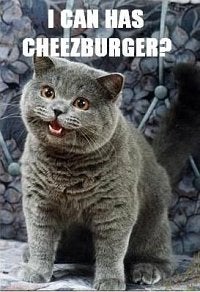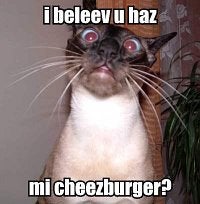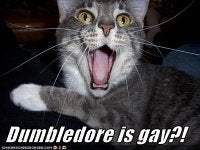UPDATED: In the 1970s, a quintet of spray paint artists called The Fabulous Five turned New York trains and subway cars into their canvases. New Yorkers were impressed with art that stretched as far as 10 cars while the Transit Authority and hardware stores where the five stole their paint were furious.
Thirty years later, the Five are gone, New York subways have been replaced with JPEG images and Adobe Photoshop has become the spray paint of the new century. The old saying “a picture is worth a thousand words” has never been more apparent as jokesters on the Internet use doctored images in place of text to get their messages across.
 |
The original “O RLY?” |
With the rise of Web-based message boards, images with a caption stamped on them have become a common form of response to a posting. One of the first notable examples of this was the “O RLY?” owl. In 2001, photographer John White posted a picture he took of a snowy white owl with a ludicrous expression on its face.
White explained to InternetNews.com that like dogs, owls cool off by panting, resulting in the bird’s expression. Someone interpreted the expression to say “oh really?” and used Photoshop to stamp “O RLY?” in large letters at the bottom.
Very quickly, the O RLY? owl became a standard response to a disputed statement. Britney Spears is a great singer? O RLY? XBox is better than PS2? O RLY? Other owls followed up, like the “YA RLY” and a number of others with captions that seemed to convey the bird’s expression.
 |
White doesn’t know what became of the bird; they have a life span of about 10 years, but it lives on in images, several video game references and a virus, W32/Hoots-A, which appeared in 2006. It would send pictures of the owl to a printer attached to the infected computer. A number of video games feature O RLY? references, as did an Australian sketch comedy show, where Hamlet’s “To be or not to be” soliloquy was translated via subtitles to include “O RLY?”, “YA RLY”, and “NO WAI!”.
Adobe, not surprisingly, is rather amused at how its software is used. “It’s actually pretty exciting to us to know that the same tool that sits at the core of the designer’s and the photographer’s workflow also can be used for everything from medical imaging to comic photo manipulation,” said Kevin Connor, senior director of product management of Adobe’s professional digital imaging products.
Drew Curtis, who runs the news aggregator FARK.com, knows a thing or two about Photoshop art. There have been Photoshop contests on FARK as far back as 2000.
“I had an idea for a caption contest,” he told InternetNews.com. “What happened was people started submitting Photoshops to the caption contest, so we decided to see if we could do a Photoshop contest and it took off so well that we stopped the caption contest. Not as a whole, but [Photoshop contests] pretty much replaced it.”
FARK now holds multiple Photoshop contests, including the “Iron Photoshop” contest — a reference to the kitschy Japanese cooking show “Iron Chef” — in which artists are given a challenge, like doing a drawing using a limited palette of colors.
Curtis said it attracts pros and amateurs alike. “Some people are so talented they can rip those things out in no time flat,” he said. “There’s more pros involved using Photoshop than you’d think.”
He also said that during the past few months, he has been contacted by a number of universities’ photo-editing teachers. Increasingly, they’re having their students enter photo editing contests like the ones on FARK.
“They say it’s a great teaching tool for that kind of thing,” he said.
Story continues on Page 2
Silly cats are big business
Owls are nocturnal creatures and not commonly photographed. Cats, on the other hand, are rather ubiquitous. The Humane Society estimates 36 percent of all U.S. households have a feline family member. Given their mischievous nature and expressive faces, cats became very popular for some fabulous Photoshopping. Silly cat pictures are called “LOLcats,” combining the “LOL” (Laughing Out Loud) acronym with “cats.”
 |
The original “I Can Has Cheezburger?” |
The madness seems to have started in early 2006 when a programmer named Eric Nakagawa posted a picture he’d found of a fat cat with a peculiar expression, with the caption “I can has cheezburger?” He found this funny, and so did readers of his blog. He began collecting more goofy cat pictures and eventually a site was born: Icanhascheezburger.com.
Goofy cats, it seems, are profitable. Icanhascheezburger.com now gets unique visitors in the “millions” each month and serves up “tens of millions” of pages. That’s according to Ben Huh, the “chief cheezburger” of Pet Holdings, the firm responsible for the site. He declined to be more specific about Icanhascheezburger.com’s traffic.
“Any time you get to the point where you have server bills to pay, you start to think of ways to pay for it,” Huh said. “And when people appreciate what you do, you try to figure out how to make it a sustainable organization.”
The site has a built in caption-creation tool, so it’s possible to add your own captions to pictures. Visitors can submit cat images and caption the picture of their cat or others that are submitted. This goes on seven days a week, but every Saturday, FARK has its own bit of cat madness, dubbed “Caturday.”
Inevitably there will be a cat-related article posted to FARK during the day. In an area where readers can comment on the story, people submit pictures with captions or even photos without captions, so others can take the images and make their own. The result is the same image sometimes being reused several times, but always to great effect.
In a testament to the popularity of goofy cat pictures, even Google has gotten in on the action. Among the many gadgets in the iGoogle custom interface is Funny Cat Photos, an add-on that randomly displays, yes, pictures of cats with Icanhascheezburger/Caturday-like captions.
In such cases, the captions are rarely dirty but always hysterically funny. They also typically rely on a staggering variety of references, including Geico commercials, Harry Potter, the films The Silence of the Lambs and 300,
and of course, parodies of the “I Can Has…” cat itself.
 |
The captions for Caturday and Icanhascheezburger.com pictures are always written in an illiterate, misspelled manner to reflect the animals’ lack of language skills. The best part is, there’s no wrong way to do it. Reading them, though, is almost akin to learning another language. Between the misspellings, obscure references and uses of Internet legends, Caturday threads can leave you as confused as amused.
On the strength of the craze, Nakagawa is relocating from Hawaii to Seattle (I can has Starbucks? Nom nom nom.) as he, Huh, and a third full-time Pet Holdings employee try to make a business out of it.
Huh said he never thought the LOLcat craze would take off like it has. “It’s surprising to us that it continues to grow, but it shows no sign of slowing down,” he said.
 |
One downside, however, is that with cat captions becoming a serious business venture, there’s also the possibility of legal wrangling over ownership of the edited photos.
FARK’s Curtis admitted he gets a little concerned about the issue, but said that so far, he hasn’t received any letters on legal letterhead yet.
Meanwhile, Huh said his site gets occasional picture submissions without the permission of the original picture’s owner, but there’s been little in the way of squabbling.
“Ninety-nine percent of the time, people are amenable to using the picture,” he said. “I think they understand this is a communal effort, almost like an art project at large.”
As a result, the LOLcats remain something of a harmless pastime for their fans.
 |
Curtis said Photoshop contests are often his most popular threads, so he enjoys the Caturday threads. “I take glee in beating a joke to death for so long that it’s not funny any more, because if you do it long enough, it becomes funny again,” he said. “They do this on ‘South Park’ all the time. It becomes funny again because it never left and eventually becomes a classic.”
He figures, however, that eventually Caturday will run its course.
“The Internet demographic moves constantly,” Curtis said. “It takes a few years, but when a new group of teenagers gets on the Internet, it gets impossible to explain an old joke to them. Try to explain ‘All Your Base‘ to an 18-year-old. They will be like, ‘That was funny at some point’?”
Updated to correct the fate of the O RLY? owl and add comments from John White.


